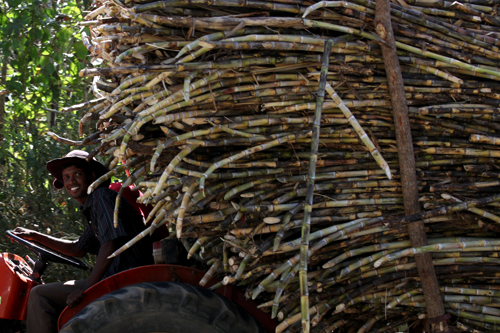Increasing the productivity of crop research institutes

A tractor transporting sugarcane.
J.A.A.S. Ranasinghe, in an article titled “Exodus of scientists from research institutes to universities – A national malady” published in the Sunday Times on November 22 has highlighted scientists leaving crop research Institutes to other institutions and that these institutions are heavily understaffed.
According to Mr. Ranasinghe, 12 experienced and qualified research officers have left the Rubber Research Institute (RRI) during the last five years. The situation at the other research institutions also may be similar.
The traditional plantation crop sector which comprises tea, rubber, coconut and sugarcane plays a key role in the Sri Lankan economy. The contribution to foreign exchange earnings by these export crops is the second-highest with a 21.5 per cent share in the total export income, thus reducing outflow of foreign exchange substantially. It also provides employment opportunities to around 500,000.
The crop research institutes play a very important role in the development of the planation sector. The output of these research institutions tends to be at a low level in the absence of qualified and experience research personnel, for they carry out research in many important areas such as breeding, control of pests and diseases, maintenance of soil fertility, economics, extension etc which are extremely important for the development of the plantation sector.
According to Central Bank annual reports, the trade deficit in Sri Lanka, has increased from Rs. 1141 billion in 2015 to Rs. 1673 billion in 2018, and has decreased to Rs. 1430 billion in 2019. Persistent trade deficits are detrimental to the country’s economy. If we are to reduce the trade deficit it is essential that exports are increased and imports reduced. In this regard, planation crops are important in increasing our export income and crop research institutions (CIs) play an important role by developing appropriate technology.
Production drop
Around 800,000 ha are cultivated with plantation crops and as indicated in table 1, production of the three major export crops viz tea, rubber and coconut do not show any substantial increase during the last six years. Tea production has been fluctuating around 300 million kg per year during this period. The annual total rubber production has decreased from 99 million kg in 2014 to 75 million kg in 2019. Coconut production too has fluctuated between 2800 and 3000 million nuts during 2015-2019. If the productivity of this sector is raised, it would be possible to increase foreign exchange earnings thereby reducing the trade deficit. We spend nearly Rs.50 billion annually to import sugar. Hence, it is important to increase our local sugar production, so that expenditure on imports can be reduced thereby reducing trade deficit.
In any attempts to reduce trade deficit by increasing production of exports crops/reducing imports of sugar, the four research institutions have an extremely important role to play. They need to conduct research to develop better clones/planting material, methods to control pests and diseases, effective management practices, better processing and value addition technologies, effective extension etc. In fact, among the many proposals in the National Policy Framework “Vistas of Prosperity and Splendor” was promotion of research related to plantation crops. Hence the Ministry of Planation Industries needs to take appropriate action to have adequate qualified research staff at the four crop research institutions. The exodus/depletion of the research staff as highlighted by Mr. Ranasinghe, is likely to have contributed to the drop in crop production levels as shown in Table 1.
There is a significant requirement for both undergraduates and postgraduates trained in subject areas related to plantation crops. Hence, there is a need to have an institution/s to impart relevant knowledge and skills related to cultivation and processing of planation crops. Currently, except the National Institute of Plantation Management (NIPM) which offers an external 3 year degree programme jointly with Wayamba University and a few diploma courses of short duration, there is no organisation providing detail knowledge and skills required for those who need training at undergraduate and postgraduate level in plantation crops.
An organisation such as a university of plantation crops in collaboration with the four research institutes would provide such knowledge and skills. In fact, during the sector budget discussions in the parliament a few days ago, the State Minister of Company Estate Reforms Tea and Rubber Estate Related Crops indicated that establishing a vocational university for plantation crops to operate under the purview of Ministry of Plantation industries would be desirable. Such a move would enhance the research capacity of the four research institutions. It will also help to save a substantial amount of public funds, human resources, time and also pave the way to produce a team of skilled scientists for the industry and retain senior and experienced researchers. The modalities of this proposed mechanism need to be discussed by the relevant authorities to achieve the higher possible economic benefits to the country.
Research staff
Increasing the number of research staff alone will not contribute to increase production or the productivity of the plantation crops. Scientists with adequate industrial experiences only can contribute to the needs of the industry. Hence attempts should be made to employ those with appropriate experience. They need to be provided with essential equipment, chemicals and manpower etc. It is also important that the institutions conduct relevant research. Research priorities, need to be based on the needs and problems in the sector. Conducting joint research and sharing equipment would reduce expenditure.
(The writer is a former Professor at Ruhuna and Rajarata Universities
and former Chairman, Sugarcane Research Institute. He can be reached at csweera@sltnet.lk).



